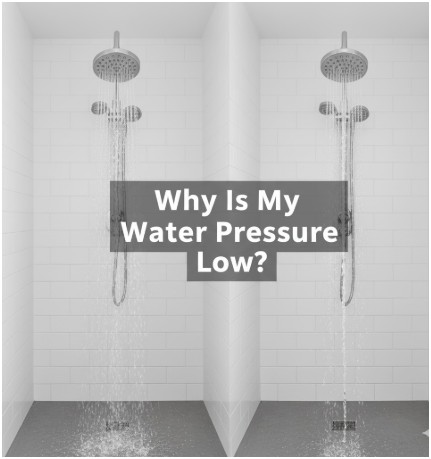A few months ago, I woke up dreaming of a hot, relaxing shower… only to get misted by what felt like a lazy drizzle. I thought my showerhead was broken, but I was wrong. That’s when I started asking myself the same question you probably are right now: why is my water pressure low?
What started as a small annoyance turned into a mini home investigation. I learned that low water pressure can stem from tiny clogs to municipal mishaps—and sometimes, the solution is hiding right under your sink.
What’s the First Step to Figure Out Why Is My Water Pressure Low?

The first thing I learned was to determine the scope of the problem. Is it just one faucet, the entire house, or the whole neighborhood? The answer tells you where to look next.
If only one fixture (say, your bathroom sink or shower) has weak flow, the issue is probably local—a clogged aerator, a gunky showerhead, or a partially closed shut-off valve.
But if multiple fixtures are weak, your main plumbing or pressure regulator might be to blame. And if even your neighbors are struggling, the problem could be with the municipal water supply.
Here’s a quick breakdown to help you diagnose it yourself:
| Situation | Likely Cause | What To Check |
| Only one fixture has low pressure | Clogged aerator or showerhead | Clean or soak in vinegar |
| Whole house affected | Main valve or pressure regulator | Ensure valves are fully open |
| Neighbors also affected | Municipal water issues | Contact your water supplier |
Could the Problem Be Inside My Plumbing System?

Once I realized the issue wasn’t just one faucet, I turned my attention to my home’s plumbing system. And that’s when the real detective work began.
Sometimes the main shut-off valve isn’t fully open. It sounds simple, but even a slightly closed valve can choke your entire home’s water pressure. Make sure the lever-style handle is parallel to the pipe or, if it’s a wheel-type, twist it counterclockwise as far as it goes.
Then there’s the pressure regulator, also called a PRV. It’s that small bell-shaped gadget near your main water line. If it fails or is set too low, your home pressure can plummet. I tested mine with a water pressure gauge on an outdoor spigot—it read 35 psi when it should’ve been closer to 60. Replacing it fixed my issue instantly.
And of course, clogged or corroded pipes can also restrict water flow. In older homes with galvanized steel pipes, corrosion builds up like plaque in arteries, narrowing the passageways. Unfortunately, the only long-term fix for that is repiping—definitely a job for a professional plumber.
Could Leaks or High Water Demand Be Why My Water Pressure Is Low?

Leaks are sneaky little culprits. Even a pinhole leak can drop your pressure noticeably. I once discovered a small drip under my kitchen sink that was barely visible—but it was enough to throw off the balance of my entire plumbing system.
Here’s an easy test:
- Turn off all your faucets and appliances.
- Check your water meter—if it’s still running, there’s a leak somewhere in your system.
Another common reason? High water demand. If your shower feels weak while the washing machine and dishwasher are running, it’s not your imagination. Water is being divided between multiple outlets. Try staggering your water usage, especially during peak hours.
And if you rely on a well system, check your well pump, pressure tank, or pressure switch. A faulty pump or malfunctioning switch can easily cause low pressure throughout your home.
What If the Low Pressure Is Only in My Hot Water?
This one had me scratching my head. When only the hot water has weak flow, it’s usually linked to the water heater. Over time, sediment builds up inside the tank, blocking the outlet valve and restricting water flow.
Flushing the heater once a year keeps things clean and efficient. If that doesn’t help, a faulty shut-off valve or a partially closed outlet valve could be the real reason. When in doubt, get a plumber to inspect it—especially if your water heater is more than 10 years old.
Could My City or Neighborhood Be the Problem?
Sometimes, the issue isn’t in your home at all. After exhausting every possible fix, I learned that the city had been flushing hydrants for maintenance, which temporarily dropped our neighborhood’s water pressure.
If your neighbors are facing the same low pressure, it’s likely a municipal supply issue. High demand periods (like mornings or evenings) or water main repairs can also cause a temporary dip in pressure.
Your best move? Call your local water supplier. They can confirm if there’s maintenance or a water main break affecting your area.
How Do I Fix Low Water Pressure Step-by-Step?
Here’s what I recommend if you’re trying to troubleshoot why your water pressure is low:
- Check all valves: Make sure every shut-off valve (main and fixture-level) is fully open.
- Clean fixtures: Remove aerators and showerheads; soak them in vinegar to dissolve mineral buildup.
- Test for leaks: Turn off all water use and inspect your water meter for movement.
- Test pressure regulator: Use a gauge to check psi—normal range is 40–70.
- Flush your water heater: If it’s a hot-water-only issue.
- Contact your water company: If all else fails, the issue may be external.
- Call a plumber: For corrosion, hidden leaks, or faulty regulators that need professional repair.
FAQs About Low Water Pressure
1. Why is my water pressure low all of a sudden?
Sudden drops usually point to a malfunctioning pressure regulator or a leak somewhere in your plumbing. It can also happen if your city is working on nearby water lines.
2. How can I increase my water pressure naturally?
Start with small fixes: open all valves, clean aerators, and flush your water heater. If that doesn’t work, a plumber can install a pressure booster pump to give your home an extra push.
3. Can a water softener cause low water pressure?
Yes. If your water softener is clogged with resin or minerals, it can restrict flow. Flushing or servicing it usually resolves the issue.
4. How much does it cost to fix low water pressure?
It varies—from under $100 for simple cleaning or valve adjustments to several thousand dollars for repiping old, corroded lines. Always get a professional diagnosis first.
Wrapping It Up: Don’t Let Weak Water Win
When I first asked myself, “why is my water pressure low?” I didn’t expect the answer to be a mix of detective work, DIY, and a few calls to my water company. But that’s the thing—low water pressure isn’t just an inconvenience; it’s a sign your plumbing might be trying to tell you something.
If you’ve checked every possible fix and your shower still feels like a gentle mist, call a pro. Sometimes the peace of mind (and the strong, satisfying shower) is worth every penny.







